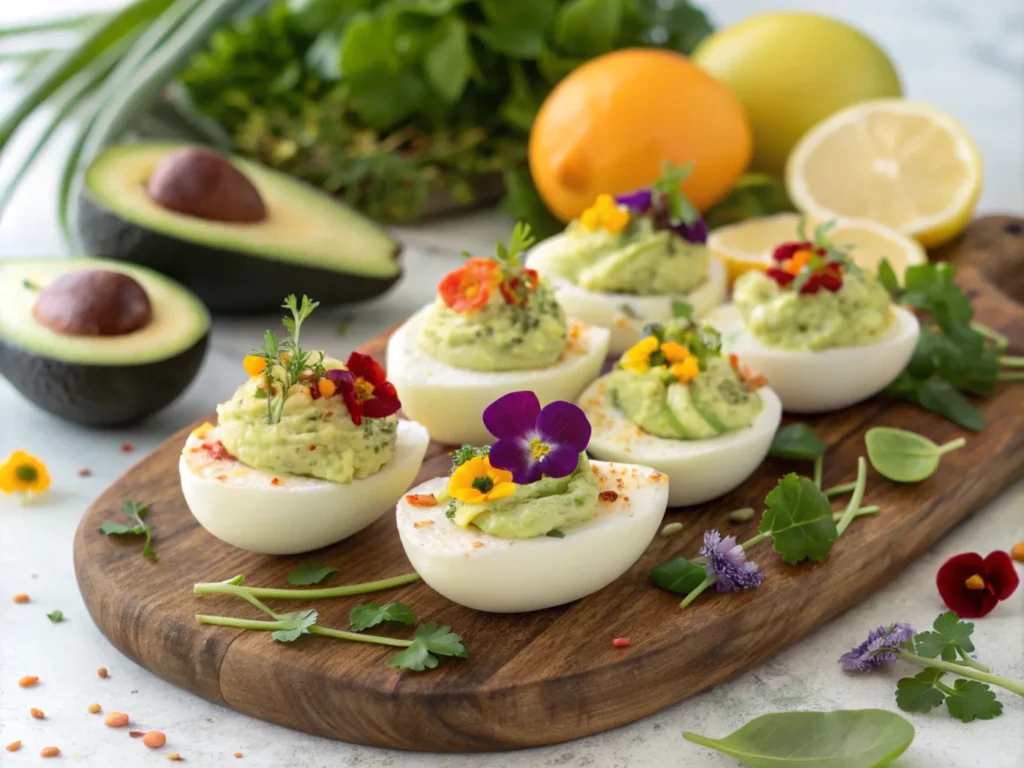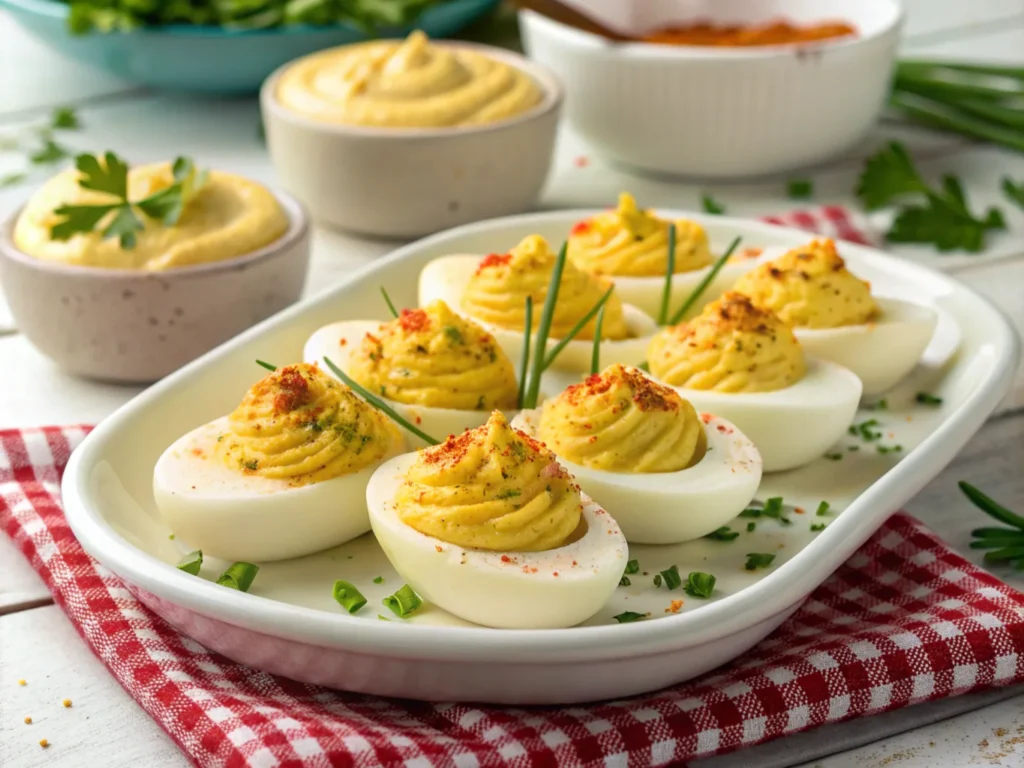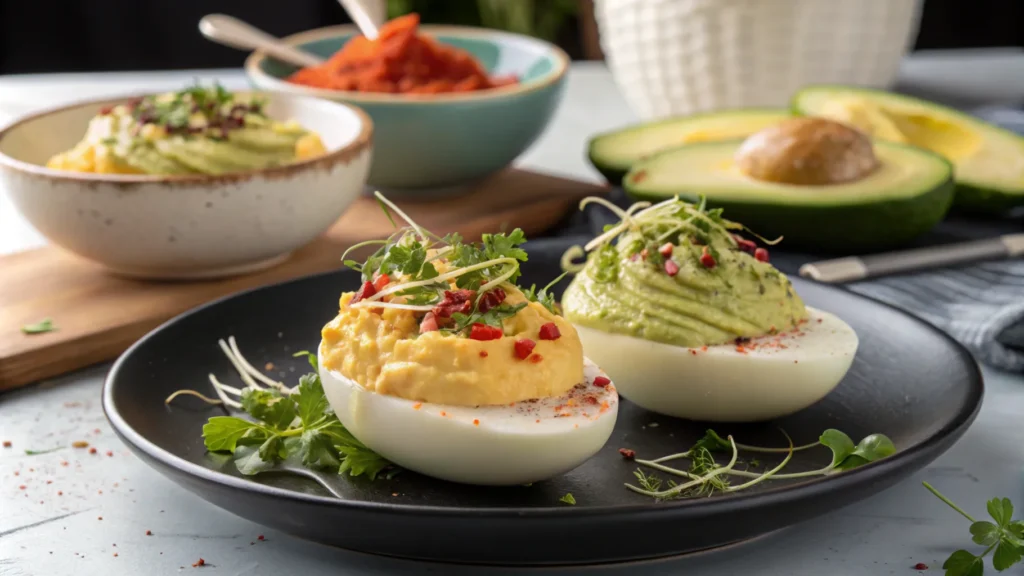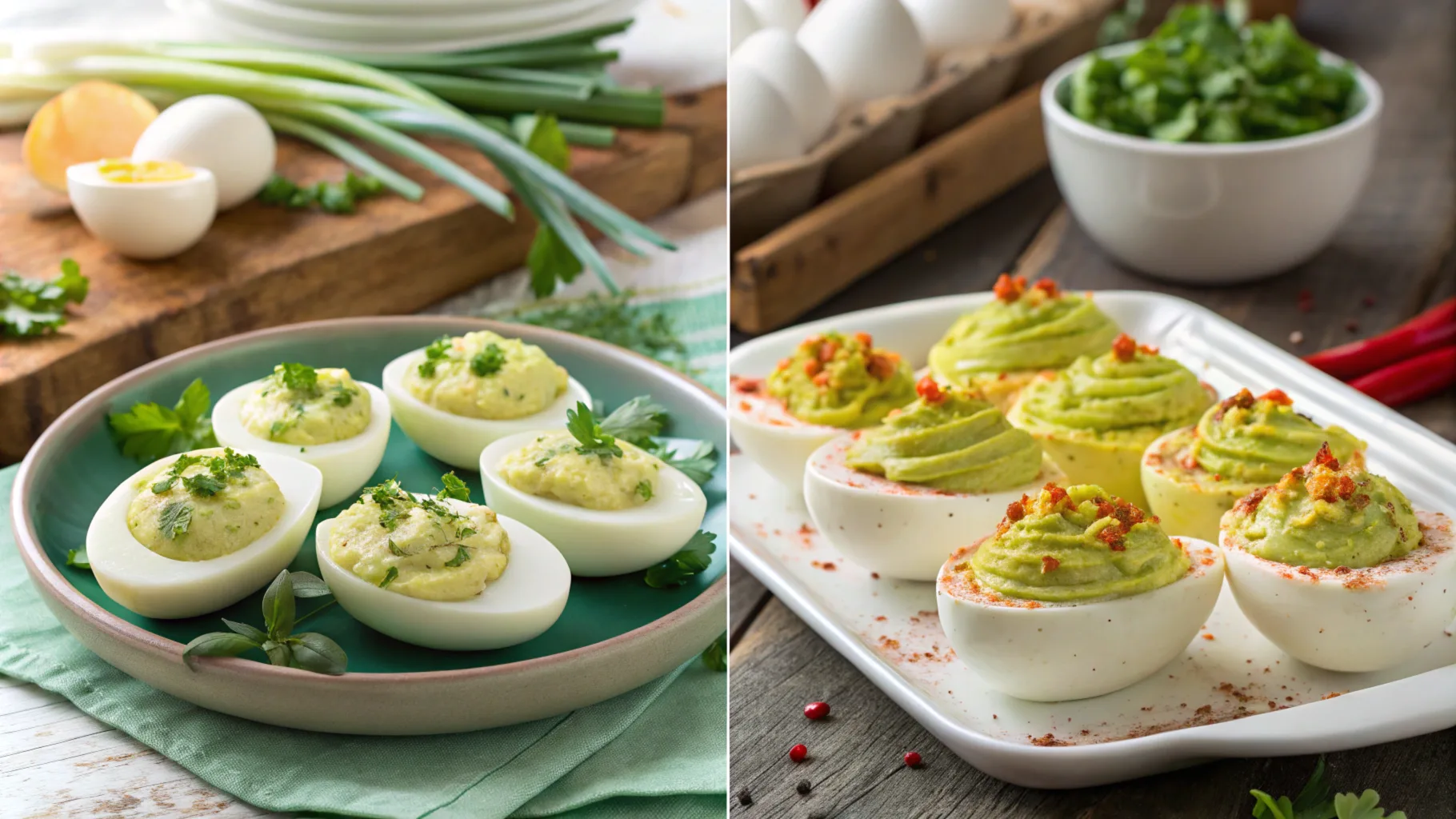Egg lovers, rejoice! Deviled eggs now have a fresh rival: angel eggs. Both are party favorites, but they differ in ingredients, preparation, and presentation. This article examines the key differences between angel eggs and deviled eggs. We’ll dive into their origins, flavors, health benefits, and recipes. Are you team deviled or team angel? Let’s find out which wins your heart (and taste buds)!
What Are Angel Eggs?
Angel eggs are a healthier version of deviled eggs. Instead of mayonnaise, they use lighter fillings like hummus, avocado, or yogurt. These changes make them lower in fat and calories. They are a great choice for anyone wanting a nutritious snack.

Angel eggs are not just healthy they’re also creative. Some recipes add superfood ingredients like spinach, turmeric, or chia seeds. These extras boost nutrition and add new flavors. Toppings like greens, seeds, or nuts give them a colorful, crunchy finish.
Angel eggs are also very flexible. You can adjust them for different diets. For vegans, you can use tofu instead of egg whites. For keto, stick to high-fat fillings like avocado or olive oil. Whatever the diet, angel eggs are a guilt-free option that still feels special.
What Are Deviled Eggs?
Deviled eggs are a classic dish with roots in Europe. They start with boiled eggs, cut in half and hollowed out. The yolks are mixed with mayonnaise, mustard, and spices. This creamy filling is piped back into the whites.
The name “deviled” became popular in the 18th century. It described foods with bold or spicy flavors. Traditional deviled eggs are tangy and rich. Modern recipes, however, often include extras like bacon, sriracha, or pickles. Toppings like paprika or chives give them a familiar look, but some versions use hot sauce or truffle oil for more excitement.

Why Compare Them?
Angel eggs and deviled eggs are both favorites, but they suit different tastes. Health-conscious eaters tend to prefer angel eggs. Deviled eggs appeal to those who enjoy richer, creamier foods.
Comparing them shows how food can change with trends. Angel eggs are growing in popularity as people seek healthier options. Understanding their differences can help you choose the perfect dish for your next gathering. Whether you want something light and fresh or creamy and bold, there’s a version for everyone!
The Concept Behind Angel Eggs
Origins of Angel Eggs
Angel eggs are a healthier twist on deviled eggs. They were created to meet the need for low-fat, tasty snacks. Their exact history is unclear, but they’ve become popular quickly. The name “angel eggs” hints at their lighter, healthier style.
Health-Conscious Twist on Deviled Eggs
Angel-eggs stand out because of their healthier ingredients. Instead of mayonnaise, they use options like avocado, Greek yogurt, or hummus. These choices lower unhealthy fats while adding heart-healthy nutrients. Ingredients like chickpeas, olive oil, and tahini increase protein and fiber. The result is a filling that is both nutritious and tasty.
Angel-eggs are a great choice for guilt-free snacking. They work well with many diets. Keto eaters can enjoy them as-is. Vegans can swap the egg whites for tofu. With less cholesterol and nutrient-rich fillings, they are a smart option for modern eating.
Popular Ingredients in Angel-Eggs
Angel-eggs are easy to customize. They encourage creativity more than deviled eggs, which often rely on mustard and paprika. Common ingredients include:
- Avocado: Adds creaminess and healthy fats.
- Hummus: A protein-packed filling with a zesty kick.
- Greek Yogurt: Light, tangy, and full of probiotics.
- Herbs and Spices: Dill, parsley, or chives for fresh flavor.
- Toppings: Microgreens, nuts, or seeds for crunch and color.
These swaps make angel eggs healthier while keeping them fun and delicious.
Understanding Deviled Eggs
Historical Background of Deviled Eggs
Deviled eggs have a long history. They date back to ancient Rome, where people served boiled eggs with spicy sauces. The term “deviled” came later, in the 18th century, to describe foods with bold or spicy flavors. Today, deviled eggs are a favorite appetizer at parties, picnics, and holidays.
Classic Ingredients and Variations
Deviled eggs are made by mixing egg yolks with mayonnaise, mustard, and vinegar. This creamy mixture is piped into the whites and topped with paprika or chives. The result is a rich, tangy snack.
Modern recipes add creative twists. Ingredients like bacon, sriracha, or blue cheese give bold new flavors. These updates keep deviled eggs exciting for all generations.
Cultural Significance
Deviled eggs are more than just food. They are symbols of comfort and tradition. In the United States, they’re essential at family gatherings and potlucks. Around the world, different versions include local flavors. Curry powder is common in India, while Scandinavia adds smoked fish. These variations show how versatile and beloved deviled eggs are.
Key Differences Between Angel Eggs and Deviled Eggs

Ingredient Variations
The main difference between angel eggs and deviled eggs is their ingredients. Deviled eggs rely on rich fillings like mayonnaise and mustard, while angel eggs use lighter options like avocado or hummus. These changes reduce calories and add nutrients like healthy fats and fiber.
Taste and Texture
Deviled eggs are bold and tangy, with a smooth, creamy texture. Angel eggs, on the other hand, taste fresher and lighter, thanks to their non-traditional fillings. While deviled eggs deliver indulgence, angel eggs focus on balance and nutrition.
Presentation Styles
Deviled eggs are usually neat and classic, with uniform fillings topped with paprika or chives. Angel eggs, however, take a more colorful and creative approach. They often feature vibrant garnishes like microgreens, edible flowers, or seeds, making them visually striking and perfect for modern gatherings.
Which Is Better for Your Dietary Preferences?
Nutritional Comparison
Angel eggs are lighter and healthier than deviled eggs. With substitutes like avocado or yogurt, they cut back on fat and calories while boosting nutrients. Deviled eggs, though richer and creamier, provide a comforting, indulgent flavor that many love.
Adaptability to Dietary Needs
Angel eggs work well for a variety of diets. They’re naturally keto-friendly and can easily be made vegan by swapping the egg whites with plant-based alternatives like tofu. Deviled eggs, while delicious, aren’t as versatile for specialized diets.
Occasions to Serve Each Option
Angel eggs are ideal for trendy, health-focused events. Their bright colors and fresh flavors make them a hit at brunches and wellness gatherings. Deviled eggs, on the other hand, are a classic choice for holidays, family parties, and other nostalgic celebrations.
For more inspiration ideas, don’t miss SweftyRecipes’ Decorative Holiday Deviled Eggs to add a festive flair to your next party.
Recipe Comparisons and Tips for Making Both
How to Make Angel Eggs Step-by-Step
To make angel eggs, start by boiling eggs until firm, then slice them in half and scoop out the yolks. Replace the yolk filling with healthier alternatives like hummus, avocado, or yogurt. Mash these ingredients together with seasonings like lemon juice, garlic, or dill, and spoon the mixture back into the egg whites. Top with microgreens, nuts, or a sprinkle of paprika for a finishing touch.
For best results, pick high-quality ingredients and try different flavor combinations. This versatility is part of what makes angel eggs so appealing.
Classic Deviled Egg Recipe with a Twist
Deviled eggs follow a similar preparation process, but with more indulgent ingredients. Combine mashed yolks with mayonnaise, mustard, and vinegar to create the filling. Use a piping bag to neatly fill the egg whites, then garnish with paprika or chives.
If you want to boost the flavor, try adding unexpected ingredients like beef bits, hot sauce, or smoked salmon. These variations bring a modern twist to the classic recipe, keeping it fresh and exciting.
Tips for Perfect Eggs Every Time
Whether making angel or deviled eggs, these tips help deliver great results:
- Use Fresh Eggs: They boil better and peel easily.
- Cool Quickly: Plunge boiled eggs into ice water to prevent overcooking.
- Season Generously: Flavors stand out when well-seasoned.
With these tips, you can confidently prepare both angel and deviled eggs that impress every time. As you try new ideas, you’ll also discover what is the difference between angel eggs and deviled eggs in flavor and creativity.
FAQs About Angel Eggs and Deviled Eggs
What Makes Angel Eggs Healthier?
Angel eggs are healthier because they use fillings like avocado, hummus, or Greek yogurt instead of mayonnaise. These swaps reduce fat and add nutrients like fiber and healthy fats. If you want a guilt-free snack, angel eggs are a great choice. But what is the difference between angel eggs and deviled eggs here? Angel eggs focus on health, while deviled eggs offer indulgence.
Can You Modify Angel Eggs to Include Traditional Ingredients?
Yes, you can! Angel eggs are very flexible. If you like the creamy taste of deviled eggs but want a healthier option, mix a little mayonnaise with Greek yogurt or hummus. You can also add paprika or spices to copy the flavor of deviled eggs while keeping them lighter.
How Did Deviled Eggs Get Their Name?
The term “deviled” started in the 18th century to describe spicy or zesty foods. Deviled eggs got this name because they include bold flavors like mustard and vinegar. This bit of history makes these eggs even more charming and timeless.

Angel Eggs vs Deviled Eggs
Ingredients
Equipment
Method
- Boil eggs: Place eggs in a saucepan, cover with water, and bring to a boil. Remove from heat, cover, and let sit for 10–12 minutes. Transfer to an ice bath to cool fully.
- Peel the eggs, slice them in half lengthwise, and gently remove the yolks into a bowl.
- Mash the yolks with Greek yogurt, hummus, or avocado. Add mustard, salt, pepper, and optional lemon juice or spices. Mix until smooth and creamy.
- Spoon or pipe the filling into each egg white. Garnish with microgreens, seeds, or paprika. Chill until ready to serve.
- Optional: For traditional deviled eggs, swap filling with mashed yolks + mayo + mustard + vinegar. Garnish with paprika and chives.
Nutrition
Notes
Tried this recipe?
Let us know how it was!Conclusion
Which One Should You Choose?
The choice between angel eggs and deviled eggs depends on your taste and the occasion. Angel eggs are great for health-conscious eaters. They use light fillings and colorful toppings, making them perfect for modern, wellness-focused events. Deviled eggs, on the other hand, are rich and creamy. They bring comfort and nostalgia to traditional gatherings.
So, what is the difference between angel eggs and deviled eggs? It comes down to flavor, nutrition, and creativity. Deviled eggs offer indulgent, classic flavors, while angel eggs focus on fresh, healthy ingredients. Each option brings something special to the table.
When to Serve Angel Eggs?
Angel eggs are ideal for events where healthy choices are key. They are light and full of nutrients, perfect for brunches, potlucks, or wellness retreats. Their colorful look also makes them great for trendy parties or gatherings focused on fresh, vibrant flavors.
If you need a dish that fits many diets, angel eggs are highly flexible. They can be made keto, vegan, or low-fat, depending on your guests’ needs. Using ingredients like hummus, avocado, or Greek yogurt makes them healthier while adding unique flavors.
Why Deviled Eggs Are a Timeless Classic?
Deviled eggs are a staple for family gatherings and holiday feasts. Their creamy, tangy filling is comforting and satisfying. Whether served with turkey at Thanksgiving or alongside salads at Easter, deviled eggs never go out of style.
Deviled eggs also offer a sense of tradition. They remind many people of home-cooked meals and family recipes. You can modernize them with toppings like turkey bacon, hot sauce, or smoked salmon, but the classic balance of creamy yolks and tangy spices remains timeless.
Bringing Creativity to the Table?
Both angel eggs and deviled eggs allow for creativity. You can even combine the two styles. For instance, blend avocado and Greek yogurt into a deviled egg filling for a lighter twist. Or, give angel eggs a spicy kick with hot sauce or cayenne pepper.
Experimenting with flavors and toppings lets you cater to different tastes. Add microgreens or edible flowers to angel eggs for a modern touch. Garnish deviled eggs with paprika or chives for a more traditional look.
Final Thoughts
Choosing between angel eggs and deviled eggs is not about picking a winner it’s about enjoying variety. Angel eggs bring fresh, modern flavors to the table, while deviled eggs offer classic comfort. Both are delicious and adaptable to any occasion.
So, next time you’re planning a menu, think about what is the difference between angel eggs and deviled eggs that matters to you. Is it health? Nostalgia? Presentation? Whatever your choice, you’re sure to serve up a dish your guests will love.
For more ideas, check out SweftyRecipes’ Healthy Deviled Eggs Without Mayo. Get creative, have fun, and watch your guests enjoy every bite!
LET’S STAY CONNECTED! FOLLOW ME ON:
Tried this recipe? I’d be thrilled to see your take on it! Snap a pic and tag me @Sweftyrecipes so I can share your delicious creations with our foodie community.

Comments are closed.